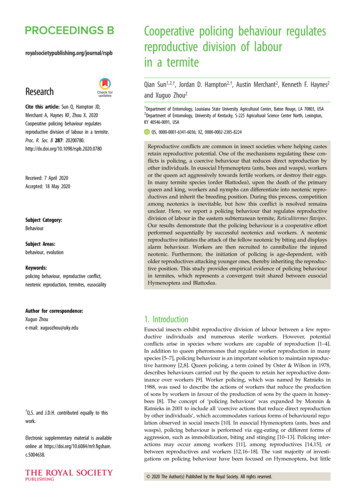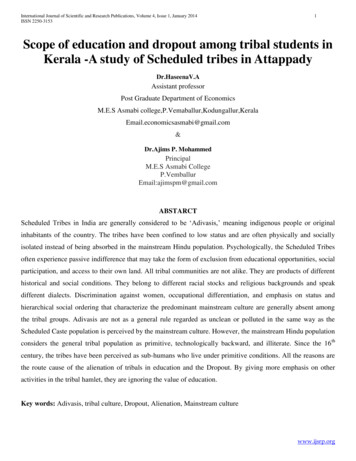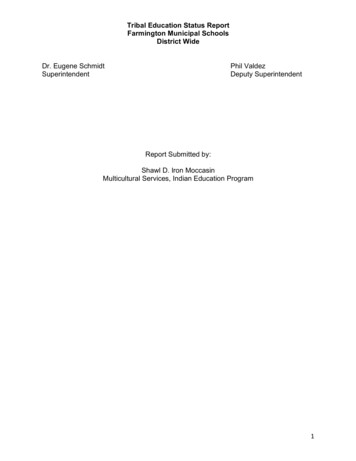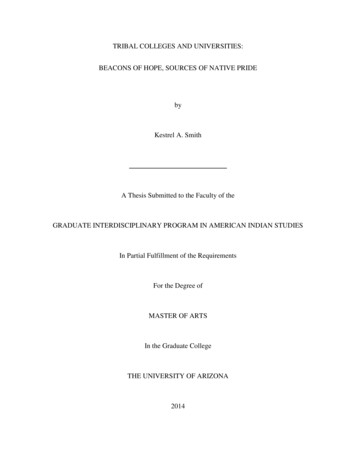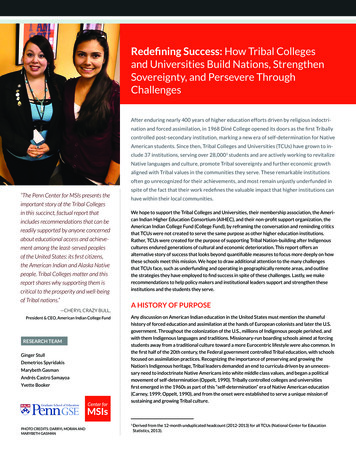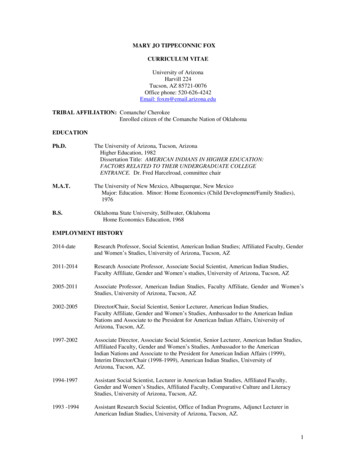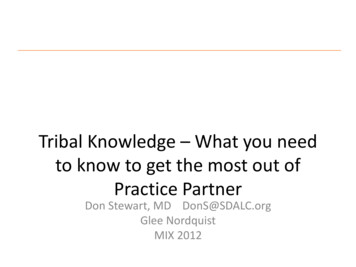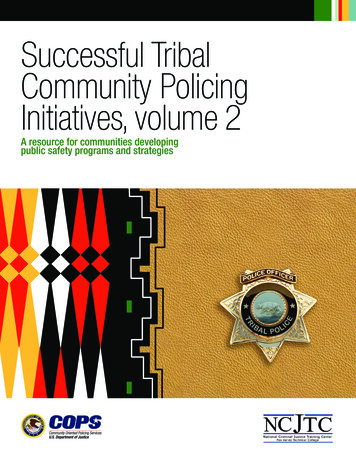
Transcription
Successful TribalCommunity PolicingInitiatives, volume 2A resource for communities developingpublic safety programs and strategies
Successful TribalCommunity PolicingInitiatives, volume 2A resource for communities developingpublic safety programs and strategies
This project was supported by Cooperative Agreement Number 2011-HE-WX-K001awarded by the Office of Community Oriented Policing Services, U.S. Departmentof Justice. The opinions contained herein are those of the author(s) and do notnecessarily represent the official position or policies of the U.S. Department of Justice.References to specific agencies, companies, products, or services should not beconsidered an endorsement by the author(s) or the U.S. Department of Justice. Rather,the references are illustrations to supplement discussion of the issues.The internet references cited in this publication were valid as of the date of thispublication. Given that URLs and websites are in constant flux, neither the author(s)nor the COPS Office can vouch for their current validity.Recommended citation:National Criminal Justice Training Center. 2021. Successful Tribal Community PolicingInitiatives, volume 2: A Resource for Communities Developing Public Safety Programsand Strategies. Washington, DC: Office of Community Oriented Policing Services.Published 2021
ContentsLetter from the Acting Director of the COPS Office. . . . . . . . . . . . . . . . . . . . . . . . . . . . . . . . . . . . . . . . . . . . . . . . vAcknowledgments . . . . . . . . . . . . . . . . . . . . . . . . . . . . . . . . . . . . . . . . . . . . . . . . . . . . . . . . . . . . . . . . . . . . . . . . . . . viIntroduction . . . . . . . . . . . . . . . . . . . . . . . . . . . . . . . . . . . . . . . . . . . . . . . . . . . . . . . . . . . . . . . . . . . . . . . . . . . . . . . . . 1Background . . . . . . . . . . . . . . . . . . . . . . . . . . . . . . . . . . . . . . . . . . . . . . . . . . . . . . . . . . . . . . . . . . . . . . . . . . . . . . . . 1What is Community Policing? . . . . . . . . . . . . . . . . . . . . . . . . . . . . . . . . . . . . . . . . . . . . . . . . . . . . . . . . . . . . . . . . 3Successful Initiatives . . . . . . . . . . . . . . . . . . . . . . . . . . . . . . . . . . . . . . . . . . . . . . . . . . . . . . . . . . . . . . . . . . . . . . . . . . 5Match-E-Be-Nash-She-Wish Band of Pottawatomi Indians . . . . . . . . . . . . . . . . . . . . . . . . . . . . . . . . . . . . . . . 5Miami Tribe of Oklahoma (Miami Nation) . . . . . . . . . . . . . . . . . . . . . . . . . . . . . . . . . . . . . . . . . . . . . . . . . . . . 10Pueblo of Isleta . . . . . . . . . . . . . . . . . . . . . . . . . . . . . . . . . . . . . . . . . . . . . . . . . . . . . . . . . . . . . . . . . . . . . . . . . . . . 13Pueblo of Laguna . . . . . . . . . . . . . . . . . . . . . . . . . . . . . . . . . . . . . . . . . . . . . . . . . . . . . . . . . . . . . . . . . . . . . . . . . . 18Wyandotte Nation . . . . . . . . . . . . . . . . . . . . . . . . . . . . . . . . . . . . . . . . . . . . . . . . . . . . . . . . . . . . . . . . . . . . . . . . . 24Ysleta del Sur Pueblo . . . . . . . . . . . . . . . . . . . . . . . . . . . . . . . . . . . . . . . . . . . . . . . . . . . . . . . . . . . . . . . . . . . . . . . 26Conclusion . . . . . . . . . . . . . . . . . . . . . . . . . . . . . . . . . . . . . . . . . . . . . . . . . . . . . . . . . . . . . . . . . . . . . . . . . . . . . . . . . . 31About the National Criminal Justice Training Center . . . . . . . . . . . . . . . . . . . . . . . . . . . . . . . . . . . . . . . . . . . . . 32About the COPS Office . . . . . . . . . . . . . . . . . . . . . . . . . . . . . . . . . . . . . . . . . . . . . . . . . . . . . . . . . . . . . . . . . . . . . . . 33
vLetter from the Acting Director of the COPS OfficeDear colleagues:Many law enforcement agencies are called upon to address critical public safety issuessuch as substance abuse in the community, gangs and criminal organizations, and violentcrime. Agencies in tribal communities also address these critical issues and often have toface them with dangerously limited resources and personnel. For more than 20 years, theOffice of Community Oriented Policing Services (COPS Office) has been proud to delivergrants for hiring, equipment and technology, and training and technical assistance directlyto tribes and tribal consortia under the Tribal Resources Grant Program—which since 2010has been part of the Coordinated Tribal Assistance Solicitation in partnership with theOffice of Justice Programs (OJP) and the Office on Violence Against Women (OVW).In 2013, the COPS Office published Successful Tribal Community Policing Initiatives:A Resource for Communities Developing Public Safety Programs and Strategies. Thatpublication summarizes some of the most promising practices and results tribalcommunities were developing based on Tribal Community Police Problem-Solving Teams(TTEAMS) training provided by Fox Valley Technical College’s National Criminal JusticeTraining Center (NCJTC) with a COPS Office grant. Since 2012, that training has beenknown as Tribal Oriented Policing Strategies (TOPS), and we are pleased to present volume2 featuring further successful strategies tribes and communities are implementing based onthat training.Tribal law enforcement and public safety agencies that consult this publication will be ableto adopt strategies and practices to implement community policing programs and improvetheir communities’ safety. It is a valuable resource, and I commend the NCJTC for itscontinued work with and for law enforcement in tribal, rural, and underserved areas.Sincerely,Robert E. ChapmanActing DirectorOffice of Community Oriented Policing Services
viSuccessful Tribal Community Policing InitiativesAcknowledgmentsWe particularly wish to thank the COPS Office including Phil Keith, Director; MattLysakowski, Senior Advisor for Tribal Affairs; and Melissa Fox, Senior Editor. This publication was developed through the dedication and support of many people. We thankthose who allowed us to interview them on numerous occasions. Those interviewedinclude the following:Catherine Adsitt(Former) Grant Writer / PlannerMatch-E-Be-Nash-She-Wish Band of Pottawatomi Indians (Gun Lake Tribe)Raul Candelaria(Former) Chief of PoliceYsleta del Sur Pueblo Department of Public SafetyYsleta del Sur PuebloJesus GarayLieutenantIsleta Police DepartmentPueblo of IsletaRonnie GilmorePolice ChiefMiami Nation Police DepartmentMiami Tribe of OklahomaGlenn JohnstonChief of PoliceWyandotte Nation Police DepartmentWyandotte NationKristi JohnsonCrime Victim AdvocateWyandotte Nation Police DepartmentWyandotte NationJesse Orozco(Former) Public Safety DirectorPueblo of Laguna Department of Public SafetyPueblo of LagunaRick RabenortChief of PoliceGun Lake Tribal Public Safety DepartmentMatch-E-Be-Nash-She-Wish Band of Pottawatomi Indians (Gun Lake Tribe)The publication development team included representatives from the National CriminalJustice Training Center of Fox Valley Technical College. Key contributors include: LynnChernich, Program Manager; Melissa Blasing, Program Manager; Diana Mann, NationalResource Development Manager; Kevin Mariano, Program Coordinator; and DonnaWells, Associate.We would also like to thank the many reviewers and editors for their suggestionsand guidance.
1IntroductionBackgroundThe Office of Community Oriented Policing Services (COPS Office) introduced theTribal Resources Grant Program (TRGP) to Indian Country in Fiscal Year (FY) 1999,which is now solicited under purpose area #1 of the Coordinated Tribal AssistanceSolicitation (CTAS). Under CTAS, the COPS Office offers funding designed to expandthe implementation of community policing and meet the most serious needs of lawenforcement in tribal nations through a broadened comprehensive program. The fundingcan be used to hire or rehire full-time career law enforcement officers and village publicsafety officers as well as procure basic equipment and training to assist in the initiationor enhancement of tribal community policing efforts. Since the program’s inception, theCOPS Office has dedicated more than 550 million to hire and train community policingofficers and purchase new equipment and technology.In FY 2011, the COPS Office awarded the Fox Valley Technical College’s National CriminalJustice Training Center (NCJTC) a cooperative agreement to provide training and technicalassistance (TTA) to the 57 tribes and agencies awarded CTAS purpose area #1 funds thatyear based on needs in the field. The NCJTC assisted these tribes and agencies in enhancing community policing by providing the Tribal Oriented Policing Strategies (TOPS)training, formerly known as the Tribal Community Police Problem-Solving Teams(TTEAMS) training.The TOPS training is intended to strengthen relationships between the community andtribal law enforcement agencies. Designed specifically for Indian Country by NativeAmerican community policing practitioners, the training brings together tribal lawenforcement, tribal leaders, youth, and elders as well as representatives from criminaljustice agencies, local governments, social service agencies, educational organizations,surrounding jurisdictions, and the community.TOPS demonstrates how law enforcement and the community can work together inorganized problem-solving teams to address key public safety issues such as crime,social disorder, and fear of crime by using the community policing philosophy. Thehighly interactive training format encompasses various instructional methods includingthe principles of adult learning, group discussion, applied learning, team building, andinteractive exercises. Throughout the training, students learn how to work together toidentify problems and underlying conditions, leverage resources, and develop creativesolutions through a six-step problem-solving process resulting in a community policingaction plan. Action plans developed as a result of training focused on key public safetyconcerns such as alcohol and substance abuse, crime related to alcohol and substanceabuse, criminal damage to property, gangs, lack of communication between and amongagencies and key stakeholders, domestic violence, juvenile delinquency, truancy, loss ofculture, lack of resources, and more.Key highlighted evaluation feedback from TOPS participants demonstrate the benefits ofthe relationship and community trust building aspects of the training as well as the six-stepproblem-solving process and overall community policing strategies discussed. Samplecomments from law enforcement include the following: “This program is a great way to better policing practices as well as gain the trustof the community.” “The training gave me an understanding of how to conduct policing with otherresources and support.” “I plan to get to know someone by spending time with them before you make anydecisions about a situation or that person.”
2Successful Tribal Community Policing Initiatives “These strategies are at the core of what we do as village public safety officers.I think that this excellent training will help us be much more effective inour communities.” “I have finally realized the benefits of community support to public safety.” “I feel that the course provided excellent materials to be used on a regular basisfor better community oriented policing techniques.”Sample comments from community stakeholders and members include the following: “I appreciated the opportunity to meet and form a friendship with ourpolice department.” “I now have empathy for police officers and have lightened up my opinions.” “As a community member of my tribe and a social worker, I didn’t expect to haveas much interest as I did. I am glad to see our police officers are on board withissues that we see as well. I really liked the teamwork and planning activities. Iwill take these skills with me to better provide service in my community.” “I thoroughly enjoyed the training. It provided me an opportunity to meet andhave valuable conversation with law enforcement and other key stakeholders.”Additional examples of general comments include the following: “I could relate to everything that was taught in this training; it incorporatedNative values.” “We have a gap between community and police. This training opened our eyeson how to bridge that gap.” “We hope that this will bring the community to a healing and help them to takepride again for their community and encourage wellness. We would not havetried this if it had not been for the training you brought here to show all of usit is possible to work together. This was an extremely positive experience. It is aroad to hope of recovery of traditional values.” “We have a big problem with teen violence, graffiti, and alcohol and drug abusein our community. No one knew where to start until now!” “I was pleasantly surprised the training was being done by Native presenters. Ithad humor, visuals, and Native culture that made it have an impact.” “This was an excellent training and was presented very well. I think it opened alot of people’s eyes on the need for community policing. It also gave us the toolsto help start community policing in our community.” “Extremely impressed with the course. Very relative material that left a deepimpression and enhanced awareness of what community policing represents.Helped me identify voids in service and opportunities for enhanced collaborations.”To date with COPS Office funding, the NCJTC has delivered 85 TOPS trainings, servingrepresentatives from approximately 130 tribes and Alaska Native Villages and more than2,500 participants.Through the FY 2011 project, the NCJTC delivered onsite specialized technicalassistance to tribes on the following topics in addition to the TOPS trainings conducted:community policing strategies, alcohol and substance abuse, methamphetamine inIndian Country, Native gangs, civilian active shooter response, critical issues in campussafety, individualized tribal community safety summits, and more. Through the project,the NCJTC also conducted four regional tribal community safety summits focusingon pressing public safety concerns in each region and multijurisdictional partnershipapproaches and promising practices in tribal community policing. Webinars focused oncrime prevention strategies, leveraging technology and media to enhance community
Introduction3policing, and facility dogs as tribal court and school resource officer partners. All webinarswere recorded and remain available as a resource. Finally, NCJTC translated the TOPStraining concepts into online learning modules. The online modules explore the keyprinciples discussed during the TOPS classroom training and are broken out into thefollowing: (1) Course Introduction, (2) Community Policing, (3) Team Building, and 4)Problem Solving. Topics covered include defining community policing, fostering positivecommunity ethics, partnership building, communication strategies, and review of asuccessful community policing strategy implemented as a result of the six-step problemsolving process. The online TOPS modules are a free resource and can be accessed raining-program.This publication highlights successful strategies implemented by FY 2011 CTAS purposearea #1 recipients and is intended to serve as a resource for communities wishing todevelop programs and strategies to improve public safety through community policingimplementation. The NCJTC’s and CTAS purpose area #1 grantees’ award periods were forthree years, so TTA was delivered through the end of 2014. In addition, some tribes neededa year or more to fully implement their community policing strategies and have enoughoutcome-based information to share for the purposes of this publication. Some informationincluded was collected as recently as spring 2020. The information contained for each of thehighlighted tribal communities comes from interviews with the lead contacts listed for eachcommunity and the tribe’s website.What is Community Policing?The COPS Office defines community policing as a “philosophy that promotes organizational strategies, which support the systematic use of partnerships and problem-solvingtechniques, to proactively address the immediate conditions that give rise to public safetyissues such as crime, social disorder, and fear of crime.”1The community policing philosophy comprises three key components: (1) communitypartnerships, (2) organizational transformation, and (3) problem solving. The first component, community partnerships, recognizes that public safety issues are rarely solvedwithout the help of relevant stakeholders and partners.2 Examples of important communitypartners include the following: Government agencies such as courts, probation and parole, corrections, schools,and social services Community members or groups such as volunteers, advocates, activists,residents, tourists, tribal elders, and formal or informal community leaders Nonprofits and service providers such as service clubs, support groups,community development corporations, faith-based organizations, and victimadvocacy groups Private businesses, chambers of commerce, visitor centers, etc. Media such as newspapers, news stations, and social media sites3The second component, organizational transformation, focuses on implementing organizational and management structural changes to ensure the philosophy of communitypolicing is infused throughout the department from management to patrol and civilianstaff. Elements of organizational transformation can include agency management (e.g.,1. Community Policing Defned (Washington, DC: U.S. Department of Justice, Offce of Community Oriented Policing Services, -p157-pub.pdf.2. Community Policing Defned (see note 1).3. Community Policing Defned (see note 1).
4Successful Tribal Community Policing Initiativesclimate and culture, leadership, labor relations, strategic planning, policies, evaluation,and structure), geographic assignment of officers; personnel (e.g., recruitment, hiring, andselection; personnel supervision and evaluation; and training), and information systems(i.e., technology).The third component, problem solving, shifts the focus of responding to a crime after itoccurs to developing proactive, creative solutions to address the underlying conditions.4The problem-solving approach represents a change in the way law enforcement thinksabout its work and also calls upon community members to contribute insight and ideas forthe overall improvement of public safety. Agencies successful in implementing communitypolicing use problem solving as a fundamental approach for officers and staff to carry outtheir functions and daily routines.5A problem-solving model commonly used in community policing is SARA (scanning,analysis, response, and assessment). The scanning component includes “identifyingrecurring problems of concern to the public and police, identifying consequences,prioritizing problems, and determining how frequently the problem occurs and how longit has been taking place.”6 The analysis component includes “understanding underlyingconditions, identifying relevant data that needs to be collected, researching what is knownabout the problem, and identifying resources that may be of assistance.”7 The responsecomponent involves “brainstorming new interventions, outlining a response plan,identifying responsible parties, identifying objectives for the response plan, and carryingout the activities.”8 The assessment component involves “process evaluation, collectingqualitative and quantitative data, determining whether the objectives were met, identifyingany new strategies needed to adjust the original plan, and conducting ongoing assessmentto ensure effectiveness.”9 The six-step problem so
Wyandotte Nation Police Department . Wyandotte Nation . Kristi Johnson . Crime Victim Advocate . Wyandotte Nation Police Department . Wyandotte Nation . Jesse Orozco . group discussion, applied learning, team b
